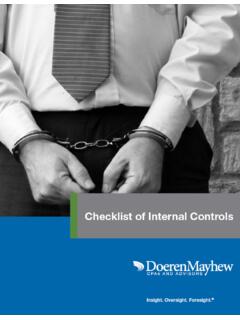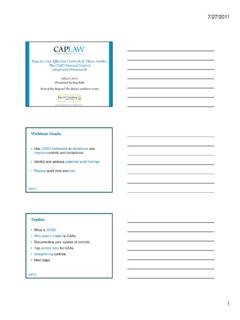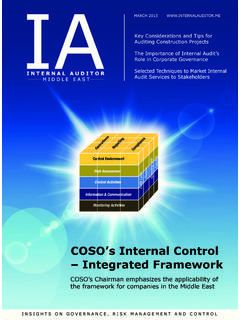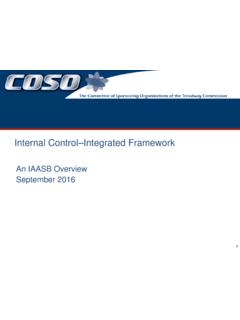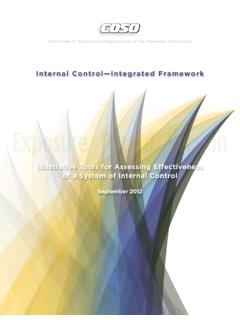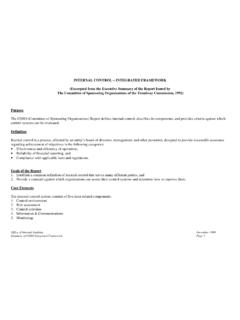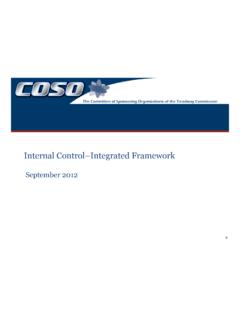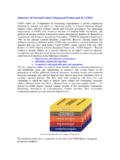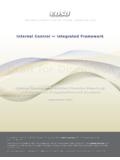Transcription of Internal Control–Integrated Framework - Doeren …
1 0 May 2013 Internal control integrated Framework1 Table of Contents COSO & Project Overview Internal control - integrated Framework Illustrative Documents Illustrative Tools for Assessing Effectiveness of a System of Internal control Internal control over External Financial Reporting: A Compendium of Approaches and examples Transition & Impact Recommended Actions Questions & Comments2 COSO & Project Overview3 COSO Overview Internal control Publications19922006200920134 Original FrameworkCOSO s Internal control integrated Framework (1992 Edition)Refresh ObjectivesUpdated FrameworkCOSO sInternal control integrated Framework (2013 Edition)Broadens ApplicationClarifies RequirementsArticulate principles to facilitate effective Internal control Why update what works The Framework has become the most widely adopted control Framework worldwide. Updates ContextEnhancements Reflect changes in business & operating environmentsExpand operations and reporting objectives5 Project timetableAssess & Survey StakeholdersDesign & BuildPublic Exposure, Assess & RefineFinalize20102011201220136 Project participantsCOSO Board of DirectorsCOSO Advisory Council AICPA AAA FEI IIA IMA Public Accounting Firms Regulatory observers (SEC, GAO, FDIC, PCAOB) Others (IFAC, ISACA, others)PwCAuthor &Project LeaderStakeholders Over 700 stakeholders in Framework responded to global survey during 2011 Over 200 stakeholders publically commented on proposed updates to Framework during first quarter of 2012 Over 50 stakeholders publically commented on proposed updates in last quarter of 20127 Project deliverable #1 Internal control - integrated Framework (2013 Edition) Consists of three volumes.
2 Executive Summary Framework and Appendices Illustrative Tools for Assessing Effectiveness of a System of Internal control Sets out: Definition of Internal control Categories of objectives Components and principles of Internal control Requirements for effectiveness8 Project deliverable #2 Internal control over External Financial Reporting: A Illustrates approaches and examples of how principles are applied in preparing financial statements Considers changes in business and operating environments during past two decades Provides examples from a variety of entities public, private, not-for-profit, and government Aligns with the updated Framework9 Internal control integrated Framework10 Update expected to increase ease of use and broaden applicationWhat is is Core definition of Internal control Three categories of objectives and five components of Internal control Each of the five components ofinternal control are required foreffective Internal control Important role of judgment in designing, implementing and conducting Internal control .
3 And in assessing its effectiveness Changes in business and operatingenvironments considered Operations and reporting objectives expanded Fundamental concepts underlying five components articulated as principles Additional approaches and examples relevant to operations, compliance, and non-financial reporting objectives added11 Environments driven Framework updatesExpectations for governance oversightGlobalization of markets and operationsChanges and greater complexity in businessDemands and complexities in laws, rules, regulations, and standardsExpectations for competencies and accountabilitiesUse of, and reliance on, evolving technologiesExpectations relating to preventing and detecting fraud COSO Cube (2013 Edition)Update considers changes in business and operating environments12 control EnvironmentRisk AssessmentControl ActivitiesInformation & CommunicationMonitoring ActivitiesUpdate articulates principles of effective Internal control1.
4 Demonstrates commitment to integrity and ethical values2. Exercises oversight responsibility3. Establishes structure, authority and responsibility4. Demonstrates commitment to competence5. Enforces accountability6. Specifies suitable objectives7. Identifies and analyzes risk8. Assesses fraud risk9. Identifies and analyzes significant change10. Selects and develops control activities11. Selects and develops general controls over technology12. Deploys through policies and procedures13. Uses relevant information14. Communicates internally15. Communicates externally16. Conducts ongoing and/or separate evaluations17. Evaluates and communicates deficiencies13 control EnvironmentUpdate articulates principles of effective Internal control (continued)1. The organization demonstrates a commitment to integrity and ethical values. 2. The board of directors demonstrates independence from management and exercises oversight of the development and performance of Internal Management establishes, with board oversight, structures, reporting lines, and appropriate authorities and responsibilities in the pursuit of objectives.
5 4. The organization demonstrates a commitment to attract, develop, and retain competent individuals in alignment with objectives. 5. The organization holds individuals accountable for their Internal control responsibilities in the pursuit of The organization specifies objectives with sufficient clarity to enable the identification and assessment of risks relating to The organization identifies risks to the achievement of its objectives across the entity and analyzes risks as a basis for determining how the risks should be managed. 8. The organization considers the potential for fraud in assessing risks to the achievement of The organization identifies and assesses changes that could significantly impact the system of Internal control . Risk AssessmentUpdate articulates principles of effective Internal control (continued)1510. The organization selects and develops control activities that contribute to the mitigation of risks to the achievement of objectives to acceptable levels.
6 11. The organization selects and develops general control activities over technology to support the achievement of objectives. 12. The organization deploys control activities through policies that establish what is expected and procedures that put policies into ActivitiesUpdate articulates principles of effective Internal control (continued)1613. The organization obtains or generates and uses relevant, quality information to support the functioning of Internal control . 14. The organization internally communicates information, including objectives and responsibilities for Internal control , necessary to support the functioning of Internal control . 15. The organization communicates with external parties regarding matters affecting the functioning of Internal control . Information & CommunicationUpdate articulates principles of effective Internal control (continued)1716.
7 The organization selects, develops, and performs ongoing and/or separate evaluations to ascertain whether the components of Internal control are present and functioning. 17. The organization evaluates and communicates Internal control deficiencies in a timely manner to those parties responsible for taking corrective action, including senior management and the board of directors, as appropriate. Monitoring ActivitiesUpdate articulates principles of effective Internal control (continued)18 Update clarifies requirements for effective Internal control Effective Internal control provides reasonable assurance regarding the achievement of objectives and requires that: Each component and each relevant principle is present and functioning The five components are operating together in an integrated manner Each principle is suitable to all entities; all principles are presumed relevant except in rare situations where management determines that a principle is not relevant to a component ( , governance, technology) Components operate together when all components are present and functioning and Internal control deficiencies aggregated across components do not result in one or more major deficiencies A major deficiency represents an Internal control deficiency or combination thereof that severely reduces the likelihood that an entity can achieve its objectives19 Update describes important characteristics of principles, , Points of focus may not be suitable or relevant, and others may be identified Points of focus may facilitate designing, implementing, and conducting Internal control There is norequirement to separately assess whether points of focus are in placeControl Environment1.
8 The organization demonstrates a commitment to integrity and ethical values. Points of Focus: Sets the Tone at the Top Establishes Standards of Conduct Evaluates Adherence to Standards of Conduct Addresses Deviations in a Timely Manner20 Update describes the role of controls to effect principles The Framework does not prescribe controls to be selected, developed, and deployed for effective Internal control An organization s selection of controls to effect relevant principles and associated components is a function of management judgment based on factors unique to the entity A major deficiency in a component or principle cannot be mitigated to an acceptable level by the presence and functioning of other components and principles However, understanding and considering how controls effect multiple principles can provide persuasive evidence supporting management s assessment of whether components and relevant principles are present and functioning21 Update describes how various controls effect principles, , control Environment1.
9 The organization demonstrates a commitment to integrity and ethical values. ComponentPrincipleControls embedded in other components may effect this principleHuman Resources review employees confirmations to assess whether standards of conduct are understood and adhered to by staff across the entityControl EnvironmentManagement obtains and reviews data and information underlying potential deviations captured in whistleblower hot-line to assess quality of informationInformation & CommunicationInternal Audit separately evaluates control Environment, considering employee behaviors and whistleblower hotline results and reports thereon Monitoring Activities22 Summary of public exposure of proposed update Interest across geographic regions approximately 50% of respondents from North America and 50% from international regions Proposed updates to Framework released for public comments.
10 December 20, 2011 to March 31, 2012 September 18, 2012 to December 4, 2012 COSO sought comments from the general public on proposed updates, including whether the: Requirements of effective Internal control are clearly set forth Roles of components, principles, and points of focus are clearly set forth Framework remains sound, logical, and useful to management of entities of all types and sizes Public comment letters available at Dec. 31, 201323 Updates are responsive to public comments Principles Provide clarity regarding the role of principles in designing, implementing, and conducting Internal control , and assessing its effectiveness Clarify descriptions of some principles, but no additional principles Effectiveness Recognize effective Internal control can provide reasonable assurance of achieving effective and efficient operations objectives (as noted before)
